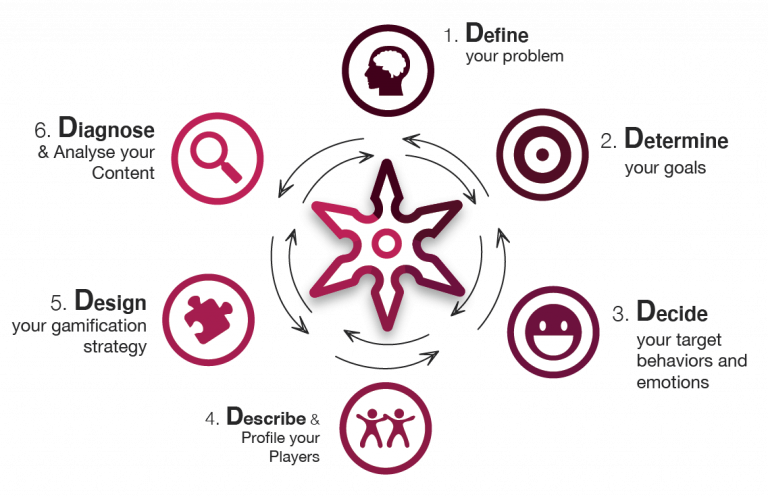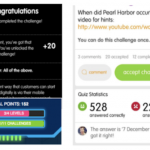Gametize's 6D Playbook & Scorecard
Introducing the Gametize 6D Playbook, our new and complete guide to gamification strategy. The transition from the 5D Framework to the 6D Playbook charts two main changes. Firstly, we have included the 6th D, Diagnose, in the post-game environment. In this phase of the Playbook, we advocate the gamification practitioner to be critical in the way one assesses and reviews the creation. There is often a tendency for the creator to “not see” aspects of their own work simply because they have spent so much time on it that they are either blinded or desensitized to any shortcomings. In their head they might have the best intentions, but what comes out at the end may fall short, and the consequences could be dire. Problems may have occurred during the pre-game planning stages (the first 4 Ds) or during the design phase (the 5th D). What we are now offering is a systematic approach, through a checklist and our very own Gametize Scorecard, to checking our own work objectively.
At a more fundamental level, calling it a Playbook, rather than a Framework suggests a more holistic approach to gamification strategy to encapsulate the entire process. We believe it needed to be extended to the post-game environment because the review and refinement process after feedback is equally critical to the game creation. There is also that change from a framework to a Playbook because it is a playbook to devise plans to counter challenges, craft strategies and employ tactics or plays to stay on top of the game. Note: We use Playbook, capital P when used as a proper noun, when referring to the 6D Playbook. We use playbook, small p here because it is used as a common noun to describe a generic playbook. We hope you’ll find the 6D Playbook as useful to you as it is to us. We use this to run our GCD sessions. You can see example of GCD here: https://docs.google.com/presentation/d/1cOki9DMXNoLFc5kYABTJnEhWTPr62qSyQv4ZhWzoBg4Let's begin with this basic checklist...
(Though if you are already a Gametize 6D ninja, just skip this altogether and go straight to Gametize Scorecard below).
1. Define your Problem
2. Determine your goals
3. Decide target behaviours and emotions
4. Describe & profile your players
5. Design your mechanics and process
6. Diagnose and analyse your content

1. Define the problem

Examples of Problem Statements:
-
Retention of knowledge is 10% after every workshop.
Root causes: The digital platform is disengaging, and there are no followups - E-learning completion is 30% and the dropout rate is high
- Job candidates still don't know much about our company in the interviews
-
Awareness on diversity is rock bottom in my company
There are no conversations, and people don't know their biases -
Nobody is talking about my brand, and a lot of money is spent on advertising
We have loyal customers but they are't talking about us - We are spending too much time generating our own content for marketing
2. Determine your goals

Examples of Goals:
- Retention of knowledge is 50% after every workshop
- E-learning completion is 70% and the dropout rate is significantly decreased
- 9/10 job candidates know our company well before the interview
- 9/10 employees in the company say they are interested in promoting diversity
- There are 1,000 mentions of my brand on social media on a daily basis
- 90% of our content is now generated by our customers
3. Decide your target behaviors and emotions

Examples of Target Behaviors:
- Users are doing challenges to compete with each other
- Users are collaborating to help each other get past the level
- Users are having conversations about diversity offline, and taking selfies to promote the awareness
- Job candidates can answer quizzes to learn more about the company
- Customers are posting reviews about the product, good or bad
- Customers are referring other customers

Examples of Target Emotions:
- "This is a rewarding game where I can win surprise prizes!"
- "I never thought this new skill I'm learning is so useful!"
- "The company makes me feel recognized and exclusive"
- "I could actually improve other people's lives by contributing in this game"
- "I know much more about myself now"
4. Describe and profile your players
- Why did Tony join the company? Why not other competitors? What sets this company apart?
- What does Tony look forward in his daily tasks, and what motivates Toni in life generally?
- What games does Tony play, on desktop or more the phone?
- Why does Tony play these games? To compete, to socialize, to explore, or to earn a sense of accomplishment?
- Which websites does Tony visit in his free time, and what content does he consume?
- What apps does Tony use on a daily basis, and on a weekly basis?
- Is there a reward Tony wants that “money can’t buy” in the company? e.g. lunch with CEO?
- What rewards that “money can buy” would motivate Tony? e.g. Movie tickets? Coffee Vouchers? Books?
- What may lead to Tony leaving the company? Lack of recognition? Lack of opportunities?
- If Tony can design a game of his own, what would it be?
- If Tony can meet anyone in the company, who will it be?
- How often does Tony get to learn new things in his work? Does he enjoy learning? If yes, why? If not, why?

Killer
Defined by:
A focus on winning, rank, and direct peer-to-peer competition
Engaged by:
Leaderboards, Ranks

Achievers
Defined by:
A focus on attaining status and achievement present goals quickly and/or completely
Engaged by:
Achievements, Badges

Socializers
Defined by:
A focus on socializing and a drive to develop a network of friends and contacts
Engaged by:
Community, Interaction

Explorers
Defined by:
A focus on exploring and a drive to discover the unknown
Engaged by:
Obscure Achievements, Compelling Story
(We’ve based this off Richard Bartle’s Taxonomy of Player Types, which you can read more about here.)

Examples of Profiles:
- Alice is a Killer who enjoys competition
- Billy is motivated by socializing and being in a community
- Charlie likes discovering content and learning new life hacks
- Alice uses Instagram everyday to post new photos of her healthy lifestyle
- Billy loves discounts, even though he is a high-income earner
Want to learn your Player Type? Take our personality quiz!
*Side note: Do not proceed if you haven’t tackled these questions. Otherwise, well done! Now that you have these pieces of information, let’s go on to design the Gametize experience, based on the following scorecard. You don’t have to hit a perfect score, but these are questions that you should keep in mind.
5. Design your gamification strategy

The next step involves creating an actionable plan to bring about a desired experience. Gamification is use as a tool to educate and advocate certain behaviour, which would be transformed into habits over time. We need to be clear on what we want to achieve, be laser focus and develop a zest for exploration. This sets the motivation needed to be achieved.
Gamification is the adoption of game mechanics into non-game context, increasing motivation through rewards. However, for it to be truly effective, there has be strong intrinsic motivations. Gamification is an influence that promotes positive behaviour and direct attention to a cause in a good way.
Designing your gamification strategy will be based on:
6. Diagnose and analyse your content
With all the feedback and data you have collected, you should then proceed to analyse them.
- What did you get wrong?
- What did you get right?
- Was there just a small detail missed that could have elevated your project to the next level?
- Did you make use of gamification accurately and effectively?
By analysing and making sense of these details, you are now able to refine your product for your users. Make use of the data you’ve gathered to create fresher content, a more experiential interface, and bring greater benefits to your work.
Another thing that needs diagnosing is the overall experience you had. Similar to the content portion, you should take the time to reflect and look back on the process of creating your gamified project. Were there areas that you struggled in? What did you do to resolve those issues, and what steps can you take to learn from them? When diagnosing and analysing is done correctly, it not only makes for a better game, but teaches you important skills as a creator.
Most importantly, remember that the 6D Playbook is an iterative process; there’s no such thing as a perfect gamification strategy! So if you find, for example, that your initial player profile isn’t accurate – go ahead and pivot, adjust, reiterate.
Visual style & Narrative
Gametize Scorecard
The Gametize scorecard is designed to measure the success of your gamification strategy. Score each of the questions out of 10, with 10 being the best score.

Step 1: Use the 6D Playbook
- Has the problem been defined, or an overall objective been identified? E.g. lack of motivation for training, implementing a long-term loyalty and contest platform
- Have the goals been determined? E.g. Increased knowledge, interests, conversion of sales
- Have the target behaviors been decided? E.g. Players will do quizzes weekly, encourage each other, work together as a group to complete challenges
- Have the players been described & profiled? E.g. Unmotivated, avid mobile user, likes & dislikes

Step 2: Game Structure & Elements
- How clear are the objectives of the games for the players? __/10 (Do players know what to expect? Do they know what the rewards are?)
- How attractive are the rewards to the described players (monetary or non-monetary? __/10 (For Enterprises, avoidance of penalties can be a form of rewards, too, e.g. do a dance in front of the office)
- Are there any “wow factors” or surprise discovery of rewards in place? __/10 (If so, are your players somewhat aware, and how easy can the early rewards be discovered?)
- How focused are the games? __/10 (Is the game too broad? Are the challenges/theme specific and consistent?)

Step 3: Challenges
- Will there be fresh challenges rolled out? If so, is the schedule well-designed? __/10 (Also, are the players aware of new challenges periodically?)
- Are the challenges relevant to the objectives/goals/problem (i.e. not random)? __/10
- Are the challenges easy to understand? __/10
- Is there a good number of challenges? (i.e. not too little or too much) __/10

Step 4: Feedback & Competition
- How clear and frequent are the feedbacks? __/10
- Are the feedbacks relevant to the objective/goals? __/10
What can the 6D Playbook & Scorecard be used for?
The 6D Playbook & Scorecard can be applied to a diverse set of use cases, from setting productivity goals to social relations.
Here are some examples of what we’ve used the 6D Playbook for:
- Employee orientation & onboarding
- Conferences and exhibitions
- Talent acquisition (i.e. recruitment)
And here are some examples of what we’ve seen our clients and workshop participants use the 6D Playbook for:
- Encouraging employees to recycle more
- Encouraging employees to adopt healthier lifestyles
- Quiz nights (ask us more about this!)
If you want to learn more about how to successfully implement a gamification strategy in your organization, head on to cheatsheet.gametize.com where we have a bunch of resources for you such as demo games, case studies, and other useful stuff.
Happy gametizing!
